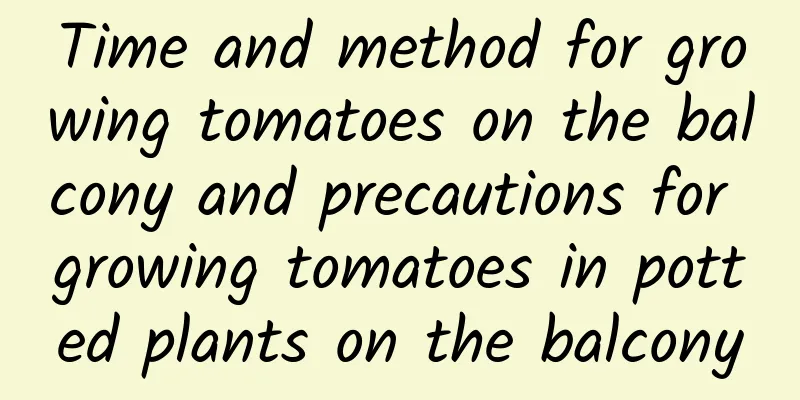Time and method for growing tomatoes on the balcony and precautions for growing tomatoes in potted plants on the balcony

|
It is good to grow tomatoes on the balcony. Some balconies have sufficient sunlight, which is conducive to tomatoes absorbing light and converting nutrients into organic matter, thereby producing high-quality tomatoes. Paying attention to fertilizer and water management can increase the yield of balcony tomatoes. Planting is relatively simple. Steps to grow tomatoes on the balcony1. Soil: Tomatoes need deep, well-drained, breathable, fertile and loose soil. The culture soil can be mixed with humus and garden soil in a ratio of 1:1. The culture soil prepared in this way can retain moisture but is not easy to accumulate water. 2. Seeds: Dwarf varieties of potted tomatoes are better, such as Nonghong No. 1. Soak the seeds in 50℃ warm water for twelve hours before sowing. When the time is up, pick them up and sow them evenly in the seedling pot. Then lightly cover them with a layer of culture soil and keep the culture soil moist. The seeds will germinate in about a week. When the seedlings grow 4 leaves, they can be transplanted. 3. Planting: The best tomato planting pot is a deeper clay pot. Fill it with culture mud, dig up the seedlings together with the soil, and plant them in the clay pot. Plant one plant in one pot. After planting, water the pot to help it take root. Key points for growing tomatoes on the balconyWhen growing tomatoes on the balcony, they should be placed in an area with plenty of sunlight to allow them to photosynthesize. This will allow them to accumulate more sugar and improve the quality of the fruit. However, the light intensity is very high at noon in summer, so shade measures need to be taken. No fertilizer is needed during the growing period of tomatoes. Keep the soil in the planting pot moist and water it about once every 3-5 days. Do not water it too frequently, otherwise the roots will rot. During the fruiting period, you can spray 0.3% potassium dihydrogen phosphate on the leaves once a week. If the plant lacks fertilizer, you can apply compound fertilizer and apply thin fertilizer frequently. |
Recommend
Cultivation methods and precautions of hydroponic Brazilian wood
Hydroponic rubber trees are very easy to grow bec...
How many times can sweet potatoes be planted in a year? How many days does it take from planting to harvesting?
How many seasons can sweet potatoes be planted in...
What is the best fertilizer for cabbage?
Cabbage fertilization time During the growth peri...
How to plant garlic, cultivation method of autumn sowing garlic
1. Prepare the soil Planting garlic in autumn is ...
The efficacy and function of white back leaves
1. Dispel wind and dampness White-backed leaves h...
Can Wisteria be grown in the north?
Can wisteria be grown in the north? Wisteria can ...
How to repot agave
1. How to replace the basin It should be changed ...
Common diseases and prevention methods of honeysuckle
The main diseases and pests of honeysuckle are br...
How to grow white sandalwood cactus and make it bloom
Winter care of white sandalwood cactus It is very...
Should the flower stems of succulents be cut off?
1. Cut off Whether to cut it off depends on the s...
How to propagate crabapple by cuttings
Begonia is famous for its delicate flowers and el...
Dahlia cultivation methods and precautions
Dahlia is famous for its bright colors and long f...
How many days does it take for coriander to sprout?
Coriander is a seasoning vegetable that many of o...
How to grow Ligustrum lucidum bonsai
1. Suitable soil When breeding, you should use so...
Can the lucky charm be grown in water? What should be put in the hydroponic culture and how much water is appropriate?
1. Can it be raised in water? Although it is not ...









